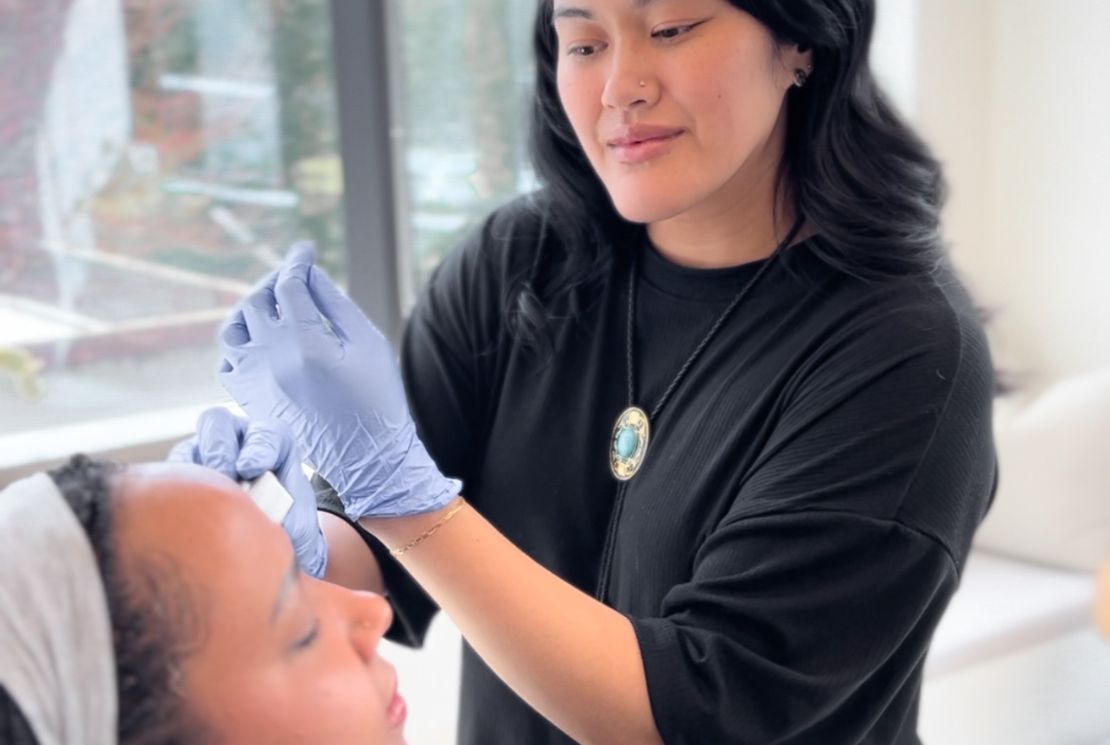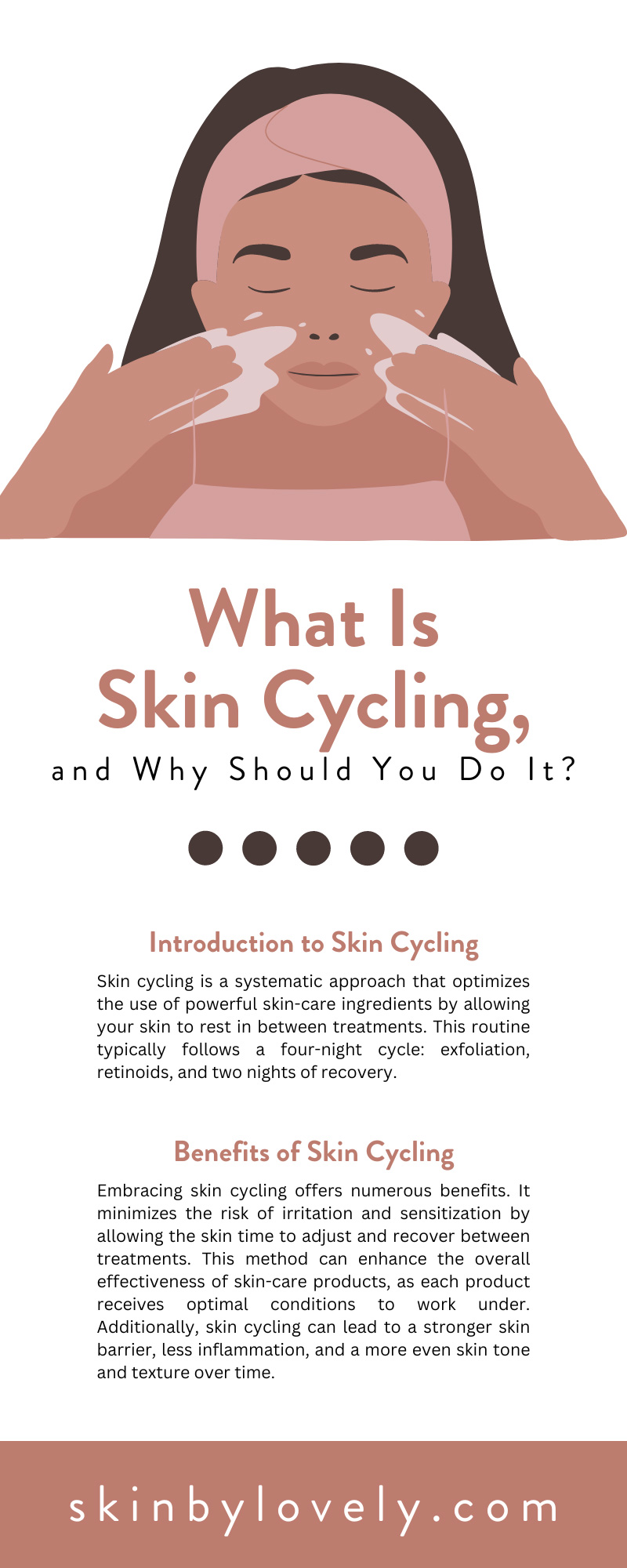Camas, WA
Injectables
Skin Rejuvenation
Hair Restoration & Growth
Shop By Category

Skin cycling is a strategic approach to skin care that involves alternating the products you use on your skin to maximize their benefits while minimizing irritation. This regimen typically spans several days, giving your skin time to absorb and react to each product effectively. Here’s an in-depth look at what skin cycling is and why you should do it.
Skin cycling is a systematic approach that optimizes the use of powerful skin-care ingredients by allowing your skin to rest in between treatments. This routine typically follows a four-night cycle: exfoliation, retinoids, and two nights of recovery.
The concept emerged from the need to use potent skin-care products without overwhelming the skin, reducing the risk of irritation, sensitivity, and damage. By dedicating specific nights to particular treatments, skin cycling ensures each product can work its magic effectively and safely.
Designated for the first night of the cycle, exfoliation is the cornerstone of skin cycling. This step is crucial because it removes the dead skin cells that can clog pores and dull the skin’s appearance. Chemical exfoliants such as alpha-hydroxy acids (AHAs) or beta-hydroxy acids (BHAs) are preferred for their ability to penetrate deeply and evenly, promoting cell turnover without physical abrasion. Proper exfoliation sets the stage for subsequent treatments, ensuring that the skin more effectively absorbs and utilizes retinoids and moisturizers.
The second night of skin cycling focuses on retinoids, which are vitamin A derivatives known for their powerful antiaging and skin-renewing properties. Retinoids accelerate cellular repair and collagen production, targeting fine lines, wrinkles, and uneven skin tone. Introducing retinoids after exfoliation ensures deeper penetration and effectiveness.
However, the potency of retinoids means they can be irritating for some people, making the following recovery nights essential to mitigating any potential adverse effects.
After the active treatments, your skin needs time to recover. The third and fourth nights are dedicated to hydration and repair. These nights should focus on soothing and nourishing the skin with ingredients such as hyaluronic acid, ceramides, and peptides. These recovery periods are essential for strengthening the skin’s barrier, hydrating, and soothing any irritation from the exfoliation or retinoid nights. This balanced approach maintains healthy, resilient skin capable of withstanding the potent effects of the active ingredients.
Embracing skin cycling offers numerous benefits. It minimizes the risk of irritation and sensitization by allowing the skin time to adjust and recover between treatments. This method can enhance the overall effectiveness of skin-care products, as each product receives optimal conditions to work under. Additionally, skin cycling can lead to a stronger skin barrier, less inflammation, and a more even skin tone and texture over time.
Skin cycling’s customizable nature makes it suitable for various skin types. Whether your skin is dry, oily, sensitive, or combination, you can tailor the products you use in each phase to meet your specific skin concerns. This adaptability makes skin cycling a versatile, inclusive skin-care strategy.
By dedicating specific nights to exfoliation and active ingredients, skin cycling ensures each product can absorb into the skin more efficiently. This targeted approach allows the skin to reap the full benefits of each ingredient, leading to more significant and visible improvements in skin health and appearance.
Constant exposure to active ingredients can lead to skin fatigue, where the skin becomes less responsive to skin-care products over time. Skin cycling combats this by rotating active ingredients and rest periods, keeping the skin engaged and responsive to treatments.
Skin cycling offers a simplified yet effective regimen for people who are overwhelmed by complicated skin-care routines. This structured approach demystifies skin care, making it more accessible and manageable. By focusing on one primary action or product each night, skin cycling clarifies the purpose and benefits of each step in your routine.
The organized nature of skin cycling fosters consistency, a critical aspect of any successful skin-care regimen. Knowing precisely which products to use and when eliminates the guesswork, making it easier to stick to a routine that yields results.
Skin cycling can also be cost effective. By using products strategically and giving your skin time to rest, you can potentially extend the life spans of your skin-care products. This efficiency benefits not only your skin but also your wallet.
The flexibility of skin cycling allows you to adapt it for seasonal changes, addressing the varying needs of your skin throughout the year. For instance, incorporating more hydrating and nourishing products during the winter months can combat dryness, while lighter, more breathable products can prevent pore congestion during the summer.
For optimal results, consider consulting with a dermatologist or an aesthetic consultant, who can provide personalized recommendations based on your skin type, concerns, and goals. These experts can also suggest specific products and adjustments to your skin cycling routine, ensuring it’s tailored to your unique needs.
The exfoliation and retinoid nights in the skin cycling routine offer opportunities to experiment with different active ingredients. This flexibility enables you to introduce new products cautiously and monitor how your skin responds, allowing for a more personalized and effective skin-care regimen.
Embarking on a skin cycling regimen is a commitment to understanding and responding to your skin’s unique needs over time. Patience is paramount, as skin renewal and repair processes are gradual and require consistent care to yield visible results. Observation plays a crucial role in this journey; paying close attention to how your skin reacts to each phase of the cycle is vital. You may notice that certain treatments bring immediate radiance, while others may initially cause mild irritation before revealing their full benefits.
Remember, skin care is deeply personal—what works for one person may not work for another. Embrace the learning curve and be willing to adjust your approach as you discover what truly works for your skin.
Now that you know what skin cycling is and why you should do it, you’re ready to embark on a skin-care journey that promises enhanced effectiveness, reduced irritation, and a routine that your skin will thank you for. As you adapt this method to fit your unique skin concerns, remember that consulting with an aesthetic consultant can offer further customization, ensuring your skin cycling routine leads to the best possible outcomes for your skin’s health and appearance.
